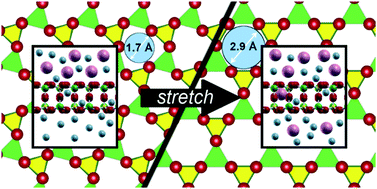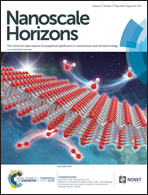An atomically thin molecular aperture: two-dimensional gallium phosphate†
Abstract
Unlocking true size- and shape-selectivity in membranes requires new materials design paradigms. In this work, a novel two-dimensional GaPO4 material is presented that can act as an adjustable and switchable molecular sieve for small molecule separations. Two-dimensional GaPO4 is constructed of a bilayer of alternating corner-sharing GaO4 and PO4 tetrahedra arranged in six-membered rings. Density functional theory calculations indicate the tetrahedra rotate in the minimum energy structure to create impenetrably small openings. In response to modest tensile stresses, however, the tetrahedra act as molecular hinges, rotating against each other to open apertures sufficient for small molecules to pass through. The result is a membrane structure with a high porosity and a relatively broad range of effective pore sizes for precise and switchable control over gas permeation. Simulations for He, Ne, and H2O reveal the ability to control the permeability over nine orders of magnitude. To achieve this adjustable separation in a scalable, practical manner, a pressure-driven device is outlined which uses small pressure differences between the permeate and retentate sides to apply the tensile stress, highlighting the simplicity of utilizing two-dimensional GaPO4 for tunable and switchable separation of small gas phase molecules.



 Please wait while we load your content...
Please wait while we load your content...